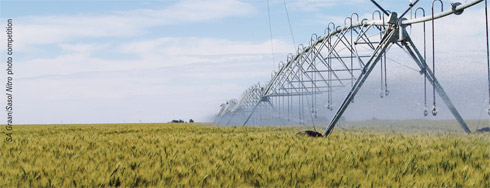April 2012

WILLEM KILIAN, BEN VAN RENSBURG, COENIE NEL, MANUS VAN DER MERWE AND ELSA VAN DER MERWE, ALL FROM THE ARC-SMALL GRAIN INSTITUTE
The 2011 season turned out to be an excellent production year under irrigation conditions. Wheat yields realised by producers were drastically higher than the medium term average for the different production regions. These positive outcomes were also reflected in the results generated in the National Wheat Cultivar Evaluation Programme.
We can attribute the higher yield levels to a number of factors that had a positive effect on production. The most important factor is probably the cooler temperatures that were experienced during the growing season. Since wheat is a cool weather crop, lower temperatures, that extend the growing period, enable the plant to produce a higher yield.
Cultivar trial results under irrigation were presented to the National Wheat Cultivar Adaptation Workgroup on 9 February 2012. The report was accepted and the new recommendations for the 2012 season were finalised. Four new cultivars, which were tested for the second year in the field trials, were added to the recommendations. These cultivars are SST 866, SST 867, SST 875 and SST 877.
The cultivar trials are analysed separately for all the irrigation regions and the data generated, present an excellent opportunity to compare the performance of new cultivars with existing ones. In the graphs, the yield reactions of irrigation cultivars are presented and discussed. The three year average results are also indicated, since this data gives an indication of the yield stability of cultivars. All the data are for the earlier planting dates in the different regions.
Results 2011
Cooler central irrigation areas
The average yield over localities and cultivars was 10,85 ton/ha (Graph 1). From the combined analyses for the first plantings, SST 806, CRN 835 and SST 884 had the highest yields, followed by CRN 826, SST 875 and SST 816.
There was not a significant difference between the first two cultivars. The three year average grain yields indicate that SST 806 produced the highest yield, followed by SST 835 and CRN 826 (Graph 2). SST 806 had a significantly higher yield than all the other cultivars. The average hectolitre mass values calculated over the years, indicate acceptable high values for all cultivars, with 82,99 kg/hl and 80,48 kg/hl recorded for 2011 and 2010 respectively.
Grain protein was on average slightly lower during 2011 at 11,94%, compared to 12,19% in the previous season. Falling number values were generally high, with an average of 368 seconds for cultivars and localities combined.
Warmer northern irrigation areas
An average yield of 6,73 ton/ha was recorded for the combined analyses for the warmer irrigation areas (Graph 3). The cultivar SST 806 produced the highest yield from the combined results, followed by SST 895 and SST 884.
There was no significant difference between the six best performing cultivars. The three year average yields indicate that PAN 3471 had the highest yield, followed by SST 806 and SST 876 (Graph 4). The first two cultivars did not differ significantly in yield. Hectolitre mass values were high, with an average of 82,20 kg/hl, compared to 80,97 kg/hl during 2010. The average protein content of the grain was low at 10,50%, similar to the 10,84% in 2010. Falling number values were acceptable, with an average value of 337 seconds recorded for the area.
Highveld
The average yield for the combined analysis for 2011 was 8,10 ton/ha (Graph 5), which is significantly higher than the 5,54 ton/ha recorded in 2010.
PAN 3471 had the highest yield, followed by SST 895 and SST 806. The first five cultivars did not differ significantly from each other. The three year average grain yields indicated that the consistently best performers at this planting time were PAN 3471, PAN 3478 and SST 835 (Graph 6).
No significant differences were found between the first four cultivars over the three year period. Average hectolitre mass values were much higher than the previous year at 81,90 kg/hl. Grain protein was very high (13,17%) with all cultivars showing values of above 12%. Falling number values were very high, with an average of 385 seconds.
KwaZulu-Natal
The combined analyses for the 2011 season showed that the cultivar SST 875 had the highest yield, followed by PAN 3478 and SST 876 (Graph 7).
The top ten performing cultivars did not differ significantly in yield. The three year average yields show that PAN 3478 consistently produced the highest yields, followed by PAN 3471 and SST 876 (Graph 8).
Hectolitre mass values were high, with an average value of 82,31 kg/hl. Grain protein was high, with an average of 12,83%, with all cultivars showing values of above 12%. Falling number values were high, with an average value of 354 seconds.
More detailed information on the performance of irrigation wheat cultivars, including data on the one year performance as well as the long term data for all the production regions and different planting times, are available in the Production Guidelines published by the ARC-Small Grain Institute on an annual basis.
Research was made possible through funding by the Winter Cereal Trust and the Agricultural Research Council.
Publication: April 2012
Section: Input Overview